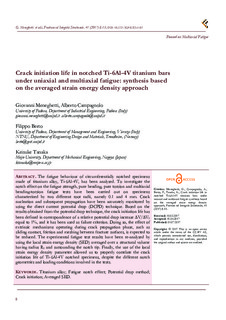| dc.contributor.author | Meneghetti, Giovanni | |
| dc.contributor.author | Campagnolo, Alberto | |
| dc.contributor.author | Berto, Filippo | |
| dc.contributor.author | Tanaka, Keisuke | |
| dc.date.accessioned | 2018-06-19T09:18:01Z | |
| dc.date.available | 2018-06-19T09:18:01Z | |
| dc.date.created | 2017-09-13T15:07:28Z | |
| dc.date.issued | 2017 | |
| dc.identifier.citation | Frattura ed Integrità Strutturale. 2017, 11 (41), 8-15. | nb_NO |
| dc.identifier.issn | 1971-8993 | |
| dc.identifier.uri | http://hdl.handle.net/11250/2502028 | |
| dc.description.abstract | The fatigue behaviour of circumferentially notched specimens made of titanium alloy, Ti-6Al-4V, has been analysed. To investigate the notch effect on the fatigue strength, pure bending, pure torsion and multiaxial bending-torsion fatigue tests have been carried out on specimens characterized by two different root radii, namely 0.1 and 4 mm. Crack nucleation and subsequent propagation have been accurately monitored by using the direct current potential drop (DCPD) technique. Based on the results obtained from the potential drop technique, the crack initiation life has been defined in correspondence of a relative potential drop increase ?V/?V0 equal to 1%, and it has been used as failure criterion. Doing so, the effect of extrinsic mechanisms operating during crack propagation phase, such as sliding contact, friction and meshing between fracture surfaces, is expected to be reduced. The experimental fatigue test results have been re-analysed by using the local strain energy density (SED) averaged over a structural volume having radius R0 and surrounding the notch tip. Finally, the use of the local strain energy density parameter allowed us to properly correlate the crack initiation life of Ti-6Al-4V notched specimens, despite the different notch geometries and loading conditions involved in the tests. | nb_NO |
| dc.language.iso | eng | nb_NO |
| dc.publisher | Italian Group of Fracture | nb_NO |
| dc.rights | Navngivelse 4.0 Internasjonal | * |
| dc.rights.uri | http://creativecommons.org/licenses/by/4.0/deed.no | * |
| dc.title | Crack initiation life in notched Ti-6Al-4V titanium bars under uniaxial and multiaxial fatigue: Synthesis based on the averaged strain energy density approach | nb_NO |
| dc.type | Journal article | nb_NO |
| dc.type | Peer reviewed | nb_NO |
| dc.description.version | publishedVersion | nb_NO |
| dc.source.pagenumber | 8-15 | nb_NO |
| dc.source.volume | 11 | nb_NO |
| dc.source.journal | Frattura ed Integrità Strutturale | nb_NO |
| dc.source.issue | 41 | nb_NO |
| dc.identifier.doi | 10.3221/IGF-ESIS.41.02 | |
| dc.identifier.cristin | 1493408 | |
| dc.description.localcode | © Authors are allowed to retain both the copyright and the publishing rights of their articles without restrictions. Frattura ed Integrità Strutturale (Fracture and Structural Integrity, F&SI) is an open access journal which means that all content is freely available without charge to the user or his/her institution. Users are allowed to read, download, copy, distribute, print, search, or link to the full texts of the articles in this journal without asking prior permission from the publisher or the author. This is in accordance with the BOAI definition of open access. F&SI operates under the Creative Commons Licence Attribution 4.0 International (CC-BY 4.0). This allows to copy and redistribute the material in any medium or format, to remix, transform and build upon the material for any purpose, even commercially, but giving appropriate credit and providing a link to the license and indicating if changes were made. | nb_NO |
| cristin.unitcode | 194,64,92,0 | |
| cristin.unitname | Institutt for maskinteknikk og produksjon | |
| cristin.ispublished | true | |
| cristin.fulltext | original | |
| cristin.qualitycode | 1 | |

